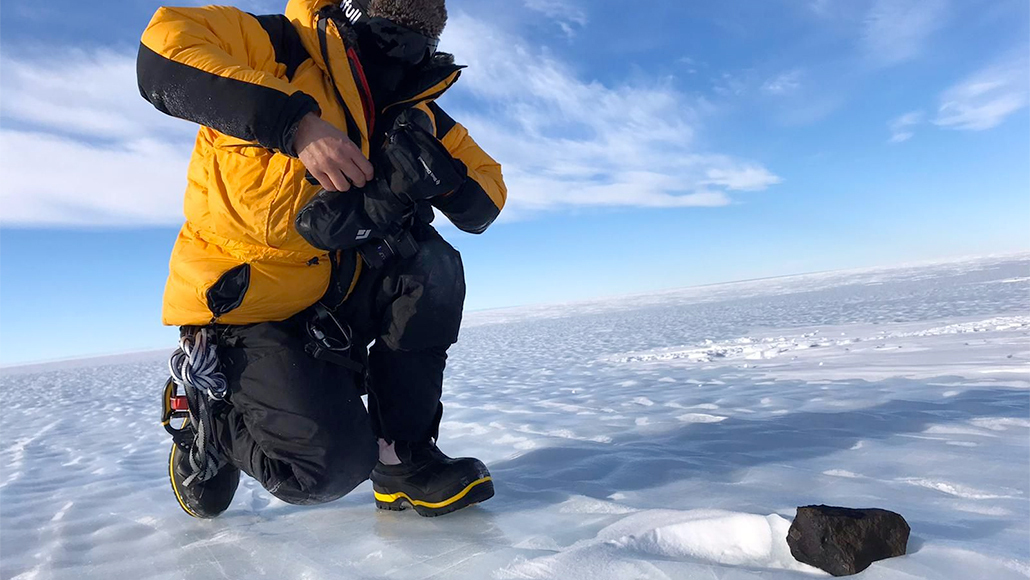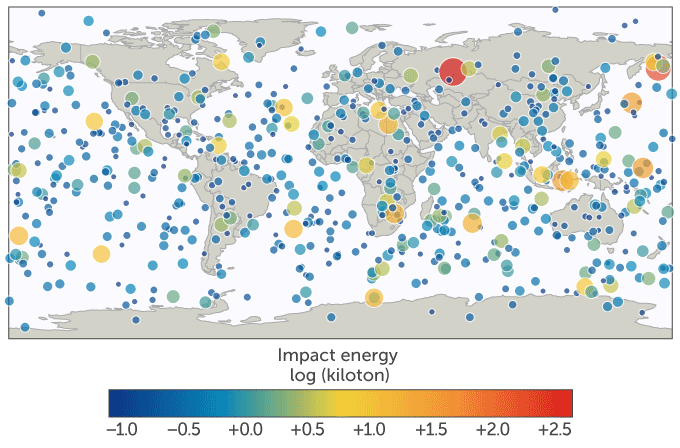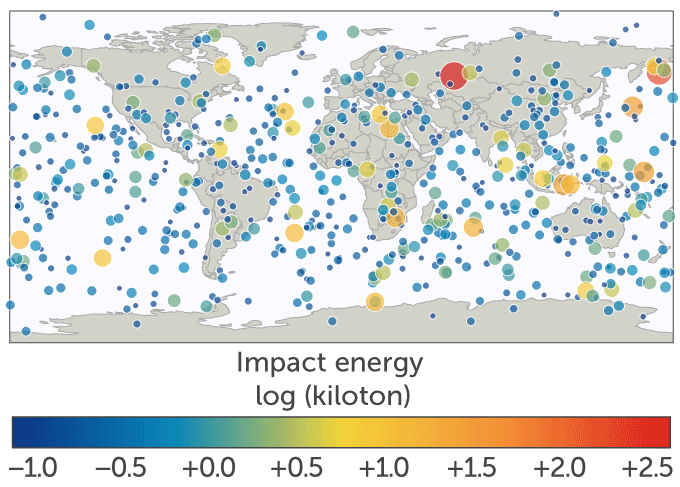Meteorites might be more likely to strike near the equator
A study reveals the amount of debris likely to hit Earth every year and where

After spotting this meteorite in Antarctica from afar, Geoffrey Evatt examines it up close.
Dr. G. Evatt/ Univ. of Manchester
Geoffrey Evatt was snowmobiling in Antarctica when he spotted an outlandish feature. A black rock stood so starkly against the diamantine ice that even the untrained eye would have known it was not from this world, but a meteorite. “You’ll never get over that high of finding the first one,” he says.
Not that it was unexpected. Before heading to Antarctica, Evatt, an applied mathematician at the University of Manchester in England, and his colleagues calculated where they might find the alien rocks. Two summers spent snaking up and down their chosen spot netted 120 in total — matching their prediction and giving them the confidence to use their calculations (plus additional ones of fireball trajectories) to create a global tally. The results, reported online April 29 in Geology, reveal that more than 17,000 impacts occur across the globe every year, with the majority of meteorites hitting low latitudes.
“The punchline is that if you want to go and see these fireballs streaking across the sky, it’s best to be near the equator,” Evatt says.
When it comes to counting meteorites, though, Antarctica is an easy target. Most meteorites collected so far have been found on the continent — thanks to the fact that a single dark rock can be spotted easily enough against a white background. Knowing how many impacts occurred within a specific region lets researchers extrapolate that number to the rest of the planet, much like how collecting rainwater in a bucket allows weather forecasters to determine how much rain fell over a larger area.
But Antarctica does present one major complication: The ice doesn’t remain still; it ebbs and flows. As it moves toward the ocean, the ice carries meteorites that fell elsewhere on the continent toward local stranding zones, eddies within the ice. Over time that ice sublimates, turning into vapor, and reveals older, hidden meteorites. Scientists have long collected meteorites within these zones, but it’s impossible to know which meteorites surfed there versus which crash-landed — and when each group arrived.
To tease out the number of meteorites that fall onto a stranding zone every year, Evatt and colleagues calculated the ice’s movement, as well as a number of other factors, including the rate of snow accumulation and ice sublimation.
In theory, multiplying the number of crashes by the total amount of area not covered in the study could produce a global estimate. Indeed, this is what previous studies have done. But that method is accurate only if meteorites strike other regions with a similar intensity. Turns out, they may not. By incorporating orbital mechanics — how Earth’s gravity pulls in passing material — into the calculations, the team found that meteorite rates vary drastically by latitude. The number of strikes at the poles is roughly 65 percent of what might be expected at the equator, the analysis indicated. (Interestingly, the global tally still falls in line with previous estimates, albeit with much smaller error bars.)
To verify the finding, the team broke down by latitude data from NASA’s Center for Near Earth Object Studies, or CNEOS, which records fireball events across the globe. That analysis revealed a similar intensity trend — a peak in the rate of meteorites at the equator with a diminished rate toward the poles. But Matthew Genge, a planetary scientist at Imperial College London not involved in the study, worries that there is too little fireball data to ground the team’s complicated calculation. In short, he argues that although the latitude trend is certainly visible in the data, delete a few data points and it disappears.
Great balls of fire
A world map shows where fireballs have been caught red-handed by U.S. government sensors. The size and color of each circle indicates how much energy a fireball had upon impact.
Fireball events recorded by the U.S. government (April 1988–March 2020)


CNEOS director Paul Chodas, however, who was also not involved in the research, says that variation in where meteorites strike makes sense. The reason is simple: Most meteorites arrive from the asteroid belt, which circles the sun in the same plane as Earth and is therefore positioned close to the equator. Genge agrees that this should be the case, but he is not sure the difference should be as extreme as what Evatt’s team reports.
The best path forward, Genge argues, will be to use additional fireball sightings from NASA, along with new systems in the works to track meteorite impacts, to see if the trend holds up.
That data will not only reveal the best locations to look for these brilliant streaks of light, but also the best locations to avoid them. That could help inform where to best place such long-term survival resources as the Global Seed Vault, a storage facility built to ensure that crop seeds survive disasters. Luckily, the bunker is already located at 78 degrees N in Norway’s Svalbard archipelago.
The ice-flow analysis could also give scientists a huge leg up when it comes to finding these solar system relics — speeding up the discovery of new clues about the formation of the early solar system and the inner rocky planets, including our own (SN: 4/18/18).







